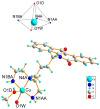Synthesis and Biological Activity of a New Indenoisoquinoline Copper Derivative as a Topoisomerase I Inhibitor
- PMID: 37834037
- PMCID: PMC10572568
- DOI: 10.3390/ijms241914590
Synthesis and Biological Activity of a New Indenoisoquinoline Copper Derivative as a Topoisomerase I Inhibitor
Abstract
Topoisomerases are interesting targets in cancer chemotherapy. Here, we describe the design and synthesis of a novel copper(II) indenoisoquinoline complex, WN198. The new organometallic compound exhibits a cytotoxic effect on five adenocarcinoma cell lines (MCF-7, MDA-MB-231, HeLa, HT-29, and DU-145) with the lowest IC50 (0.37 ± 0.04 μM) for the triple-negative MDA-MB-231 breast cancer cell line. Below 5 µM, WN198 was ineffective on non-tumorigenic epithelial breast MCF-10A cells and Xenopus oocyte G2/M transition or embryonic development. Moreover, cancer cell lines showed autophagy markers including Beclin-1 accumulation and LC3-II formation. The DNA interaction of this new compound was evaluated and the dose-dependent topoisomerase I activity starting at 1 μM was confirmed using in vitro tests and has intercalation properties into DNA shown by melting curves and fluorescence measurements. Molecular modeling showed that the main interaction occurs with the aromatic ring but copper stabilizes the molecule before binding and so can putatively increase the potency as well. In this way, copper-derived indenoisoquinoline topoisomerase I inhibitor WN198 is a promising antitumorigenic agent for the development of future DNA-damaging treatments.
Keywords: DNA intercalation; adenocarcinoma; copper(II) complex; indenoisoquinoline; molecular modeling; topoisomerase I.
Conflict of interest statement
The authors declare that the research was conducted in the absence of any commercial or financial relationships that could be construed as a potential conflict of interest.
Figures







Similar articles
-
A Novel Copper(II) Indenoisoquinoline Complex Inhibits Topoisomerase I, Induces G2 Phase Arrest, and Autophagy in Three Adenocarcinomas.Front Oncol. 2022 Feb 24;12:837373. doi: 10.3389/fonc.2022.837373. eCollection 2022. Front Oncol. 2022. PMID: 35280788 Free PMC article.
-
New benzothienopyran and benzothienopyranopyrimidine derivatives as topoisomerase I inhibitors: Design, synthesis, anticancer screening, apoptosis induction and molecular modeling studies.Bioorg Chem. 2023 Aug;137:106638. doi: 10.1016/j.bioorg.2023.106638. Epub 2023 May 27. Bioorg Chem. 2023. PMID: 37257374
-
Design, synthesis and biological evaluation of 3-substituted indenoisoquinoline derivatives as topoisomerase I inhibitors.Bioorg Med Chem Lett. 2016 Feb 1;26(3):1068-1072. doi: 10.1016/j.bmcl.2015.12.014. Epub 2015 Dec 7. Bioorg Med Chem Lett. 2016. PMID: 26725027
-
Design, synthesis, molecular docking and anti-proliferative evaluations of [1,2,4]triazolo[4,3-a]quinoxaline derivatives as DNA intercalators and Topoisomerase II inhibitors.Bioorg Chem. 2020 Dec;105:104399. doi: 10.1016/j.bioorg.2020.104399. Epub 2020 Oct 21. Bioorg Chem. 2020. PMID: 33113414
-
Development of Furo[2,3-b]quinoline Derivatives with Anti-Breast Cancer Property by Targeting Topoisomerase II.Anticancer Agents Med Chem. 2021;21(12):1482-1489. doi: 10.2174/1871520620999201103201348. Anticancer Agents Med Chem. 2021. PMID: 33155915
Cited by
-
Mechanisms of Copper-Induced Autophagy and Links with Human Diseases.Pharmaceuticals (Basel). 2025 Jan 15;18(1):99. doi: 10.3390/ph18010099. Pharmaceuticals (Basel). 2025. PMID: 39861161 Free PMC article. Review.
References
-
- Zhang P., Sadler P.J. Advances in the design of organometallic anticancer complexes. J. Organomet. Chem. 2017;839:5–14. doi: 10.1016/j.jorganchem.2017.03.038. - DOI
-
- Anthony E.J., Bolitho E.M., Bridgewater H.E., Carter O.W.L., Donnelly J.M., Imberti C., Lant E.C., Lermyte F., Needham R.J., Palau M., et al. Metallodrugs are unique: Opportunities and challenges of discovery and development. Chem. Sci. 2020;11:12888–12917. doi: 10.1039/D0SC04082G. - DOI - PMC - PubMed
MeSH terms
Substances
Grants and funding
LinkOut - more resources
Full Text Sources
Miscellaneous

